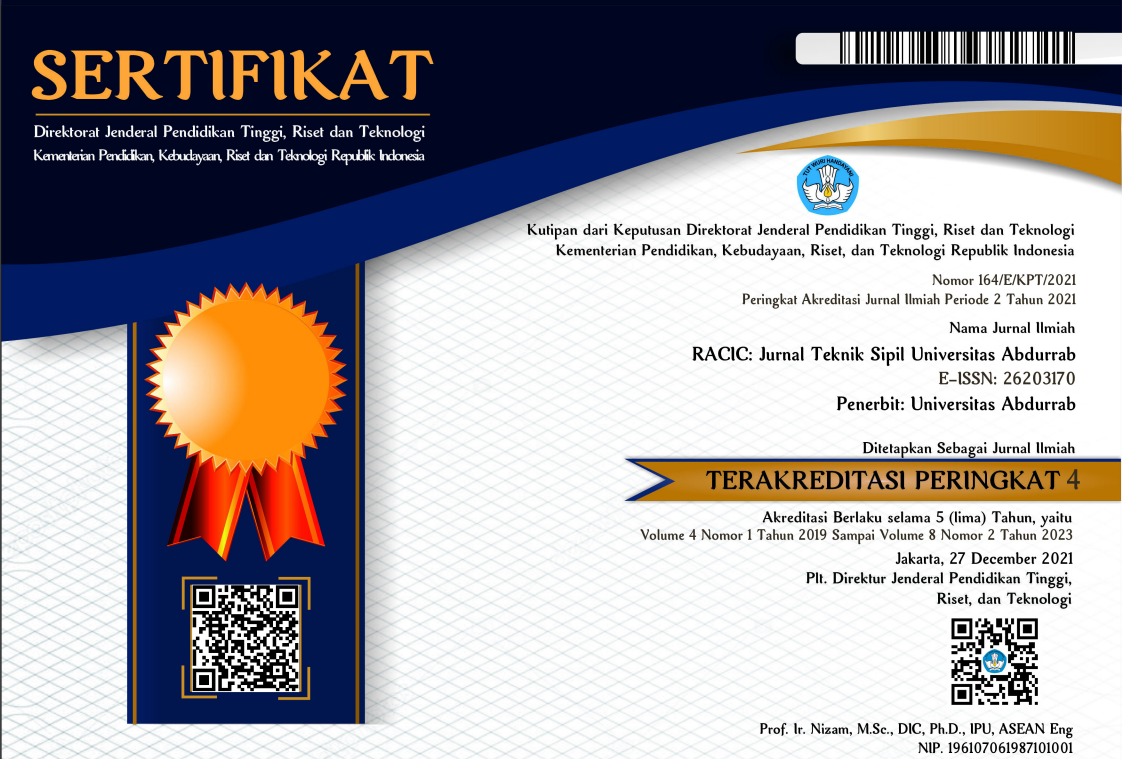PENURUNAN KEKUATAN TANAH TERSTABILISASI PALM OIL FUEL ASH BERBASIS ALKALI AKTIVATOR MATERIAL DILINGKUNGAN GAMBUT
DOI:
https://doi.org/10.36341/racic.v8i1.3530Keywords:
Sand; POFA; Alkali: Peat WaterAbstract
Peat water contains low pH and acid caused corrosive on cementation structure as stabilized soil based alkali activated POFA. The soil samples mixed with different percentages of POFA (5%, 10%, and 15%) and alkali activator solution (sodium silica; Na2SiO3) and sodium hydroxide, NaOH) were immersed in peat water for various durations (0, 7, 14, and 28 days). The test results for the physical properties of the soil showed that the addition of POFA decreased the plasticity index and increased the optimum moisture content (OMC) while reducing the dry density (MDD) of the soil mixture. Furthermore, the unconfined compressive strength test indicated that the soil's strength increased at a 5% and 10% POFA content after 7 days of immersion, with strengths of 760 kPa and 1312 kPa, respectively. However, the strength significantly decreased by over 50% after 28 days of immersion, reached 365 kPa and 372 kPa for the respective POFA contents. A slight increase in soil strength was observed with the addition of 15% POFA content during the immersion period. Although the strength obtained after 28 days was almost the same for all mixtures at 356 kPa, higher levels of aluminosilicate synthesis as 15% POFA can enhance the bonding strength between soil particles, making the test specimen more resistant to acid attack.
Downloads
References
Firoozi, Ali Akbar et al. (2017) ‘Fundamentals of soil stabilization’, International Journal of Geo-Engineering. Springer Singapore, 8(1). doi: 10.1186/s40703-017-0064-9.
Ghadir, P. and Ranjbar, N. (2018) ‘Clayey soil stabilization using geopolymer and Portland cement’, Construction and Building Materials. Elsevier Ltd, 188, pp. 361–371. doi: 10.1016/j.conbuildmat.2018.07.207.
Hashim, A. N. et al. (2015) ‘Effect of Sodium Hydroxide (NaOH) Concentration on Compressive Strength of Alkali-Activated Slag (AAS) Mortars’, Applied Mechanics and Materials, 754–755, pp. 300–304. doi: 10.4028/www.scientific.net/amm.754-755.300.
Joseph Davidovits (1994) ‘Joseph Davidovits. (1994). High-Alkali Cements for 21 sf Century Concretes. ACI Special Publication, 144, 383–398.High-Alkali Cements for 21 sf Century Concretes’, ACI Special Publication, 144, pp. 383–398.
Khoiriyah, N. L. and Maisytoh, D. P. (2016) ‘Karakteristik Mortar Geopolimer Dengan Perawatan Oven Pada Berbagai Variasi Waktu Curing’, Jurnal Teknik Sipil, 15(1), pp. 1–8.
Olivia, M. (2015) ‘Geopolimer Sebagai Material Infrastruktur Berkelanjutan Di Lingkungan Gambut’, Annual Civil Engineering Seminar, p. 6.
Purbasari, A., Samadhi, T. W. and Bindar, Y. (2018) ‘The effect of alkaline activator types on strength and microstructural properties of geopolymer from co-combustion residuals of bamboo and kaolin’, Indonesian Journal of Chemistry, 18(3), pp. 397–402. doi: 10.22146/ijc.26534.
Runyut, D. A. et al. (2018) ‘Microstructure and Mechanical Characterization of Alkali-Activated Palm Oil Fuel Ash’, Journal of Materials in Civil Engineering, 30(7), p. 04018119. doi: 10.1061/(asce)mt.1943-5533.0002303.
Tangchirapat, W., Jaturapitakkul, C. and Chindaprasirt, P. (2009) ‘Use of palm oil fuel ash as a supplementary cementitious material for producing high-strength concrete’, Construction and Building Materials. Elsevier, 23(7), pp. 2641–2646. doi: 10.1016/J.CONBUILDMAT.2009.01.008.
Downloads
Published
Issue
Section
License
1. Copyright of all journal manuscripts is held by the RACIC : Rab Construction Research
2. Formal legal provisions to access digital articles of electronic journal are subject to the provision of the Creative Commons Attribution-ShareAlike license (CC BY-NC-SA), which means that RACIC : Rab Construction Research is rightful to keep, transfer media/format, manage in the form of databases, maintain, and publish articles.
3. Published manuscripts both printed and electronic are open access for educational, research, and library purposes. Additionally, the editorial board is not responsible for any violations of copyright law.
licensed under a Creative Commons Attribution-ShareAlike 4.0 International License.





